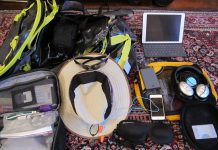Bhutan is known as “Drukyul” (the land of the Thunder Dragon), which sounds much more violent than you will find it to be. Perhaps due to the fear that the name strikes, the country has never been colonized, and it’s independence from giant neighbors (China and India) has endured for centuries. Located on the ancient Silk Road, the Bhutanese state developed as a Buddhist theocracy headed by a spiritual leader, the Druk Gyalpo (Dragon King). Unlike most countries which rate themselves based on Gross National Product (measured on a monetary scale), the philosophy which guides the government of Bhutan is based on Gross National Happiness (measured on the happiness and well-being of the population).
Paro Taktsang, commonly known as The Tiger’s Nest, is a sacred monastery built on the side of a cliff above the upper Paro valley in Bhutan. Legend claims that Padmasambhava, the Guru who brought Buddhism to Bhutan, arrived at this spot upon a flying tigress and lived in a cave for several months meditating. Springing forth from this location, Buddhism became the official religion of Bhutan, with currently more than 75% of the population practicing. Followers of the Guru established the cave as a sacred meditation site, and the monastery was built around it in 1692.
Since I forgot to pack my flying tiger, I opted for the second-choice steed: a horse. My many emails back and forth organizing my trip failed to inform me that the horses in question, Bhutia Horses, are just a little larger than western ponies. Though the horses didn’t communicate as such, I could see the terror in their eyes as I approached that fateful morning with my 6’3” frame. After confirming that none of the horses were larger, I decided to skip the ride and hike up the mountain with my guide (who was going to walk anyway). We started early in the day, and the weather was perfect for a brisk hike. We had the whole day scheduled for the round trip journey, based partly on the fact that the horses take longer and not knowing how many visitors would be on the trail, and we made it to the top in 1 hour and 45 minutes (with very few stops).
Along the trail are many beautiful vistas, a Tea House and a special viewpoint. Both the Tea House and the special viewpoint (just 0.4 miles from the temple) offer special photo opportunities of the site. Until sometime in the early 2000’s, the viewpoint was the closest non-Buddhists could come to the monastery.
More about the horses
According to my guide, the journey to Taksang is considered a pilgrimage and should take effort; thereby earning the merit you achieve. Taking a horse makes it easier, so consequently less merit is earned, perhaps also due to the suffering of the horse. Of course, if you are otherwise unable to make the journey, your merit should not be reduced by your necessity to take a horse.
Hiking to Taksang
The hike is “only” 2.6 miles, but it’s straight up (altitude change is 1,700 ft). Really, it’s not that bad if you take it slow. But remember that the oxygen available will already be less than you are used to at the starting point of 8,525 ft above sea level, and be even less when you reach the temple at 10,232 ft. Roughly half the way up is a Tea House (also referred to as a Cafeteria), which offers beautiful views and is in sight of the Temple. I suggest you wear layers of clothing so you can adjust your coverings to the changing temperature as you climb (both your body temperature and that of your surroundings).
Bhutanese Prayer flags
Hanging prayer flags is considered performing a good deed providing merits. The flags are inscribed with auspicious emblems and texts evoking mantras, prayers and blessings. It is believed that when the wind blows past the flag, these prayers and blessings are carried through the air and add to the universal vibrations along with chants and other forms of worship.
The colors represent the five elements: Yellow (Earth), Green (Water), Red (Fire), White (air) and Blue (sky).
They are omnipresent throughout the Buddhist world. Attached to every significant structure and many homes and public spaces.
![]()
TIP: Skip the horses and hike up. The extra merit will come in handy.
 Why go?
Why go?
- To see the Tiger’s Nest. An extraordinary temple built on the side of a cliff, surrounding the original caves which served as home for the guru who brought Buddhism to Bhutan.
- This is a beautiful country, off the beaten-tourist trail, with an opportunity to connect with nature.
- There are many hiking opportunities.
- The temples are less crowded than they are in most (all?) other Buddhist countries.
![]()
 What you need to know:
What you need to know:
- You can’t be in the country without a local guide. This controls the tourists while in the country, and also generates income for the population.
- The government enforces a minimum fee of about $200-$250 per day per person visiting the country. The fees are supposed to help protect Bhutan’s culture, environment and people.
- Photography is not allowed in the monasteries. In fact, at Taktsang, you are required to leave your camera at the entrance. But bring it with you on the hike, as the views on the journey are worth the extra weight.
- The monastery was severely damaged by a fire which broke out in 1998, probably started by lighting or an overturned butter lamp. It was completely restored based on old photographs and diaries.
The Tiger’s Nest
Location: Bhutan
.
My commentary to my friend, Debbie about the hike.
.
Paro Taktsang, commonly known as The Tiger’s Nest, is a sacred monastery built on the side of a cliff above the upper Paro valley in Bhutan. Legend claims that Padmasambhava, the Guru who brought Buddhism to Bhutan, arrived at this spot upon a flying tigress and lived in a cave for several months meditating. Springing forth from this location, Buddhism became the official religion.
Head to the link in my profile for more details: @mytravels.hdf
.
Video taken: 10/2011
.
#bhutan #parotaktsang #parotaktsangmonastery #tigersnest #bhutantravel #travelphotography #mytravels.hdf #hikebhutan
Great Budda Dordenma
Location: Bhutan
.
169 feet tall!
.
Great Buddha Dordenma is a gigantic Shakyamuni Buddha statue in the mountains of Bhutan celebrating the 60th anniversary of fourth king Jigme Singye Wangchuck. The statue houses over one hundred thousand smaller Buddha statues, each of which, like the Great Buddha Dordenma itself, are made of bronze and gilded in gold. The Great Buddha Dordenma is sited amidst the ruins of Kuensel Phodrang, the palace of Sherab Wangchuck, the thirteenth Desi Druk, overlooking the southern approach to Thimphu, the capital of Bhutan. Construction began in 2006 and was planned to finish in October 2010, however construction did not conclude until 25 September 2015. The completed work is one of the largest Buddha rupas in the world, at 169 feet (52 m) and contains 100,000 8-inch-tall and 25,000 12-inch-tall gilded bronze Buddhas.
- From Wikipedia
.
Head to the link in my profile for more details: @mytravels.hdf
.
Picture taken: 10/2011
.
#bhutan #dordenmabuddha #dordenmabuddhastatue #greatbuddha #travelphotography #mytravels.hdf #
The Tiger’s nest
Location: Bhutan
.
Taking a deserved rest on the way back down.
.
Paro Taktsang, commonly known as The Tiger’s Nest, is a sacred monastery built on the side of a cliff above the upper Paro valley in Bhutan. Legend claims that Padmasambhava, the Guru who brought Buddhism to Bhutan, arrived at this spot upon a flying tigress and lived in a cave for several months meditating. Springing forth from this location, Buddhism became the official religion of Bhutan, with currently more than 75% of the population practicing. Followers of the Guru established the cave as a sacred meditation site, and the monastery was built around it in 1692. .
Head to the link in my profile for more details: @mytravels.hdf
.
Picture taken: 10/2011
.
#bhutan #parotaktsang #parotaktsangmonastery #tigersnest #bhutantravel #travelphotography #mytravels.hdf #hikebhutan
Bhutanese Prayer flags
Location: Bhutan
.
Hanging prayer flags is considered performing a good deed providing merits. The flags are inscribed with auspicious emblems and texts evoking mantras, prayers and blessings. It is believed that when the wind blows past the flag, these prayers and blessings are carried through the air and add to the universal vibrations along with chants and other forms of worship.
The colors represent the five elements: Yellow (Earth), Green (Water), Red (Fire), White (air) and Blue (sky).
They are omnipresent throughout the Buddhist world. Attached to every significant structure and many homes and public spaces.
.
Head to the link in my profile for more details: @mytravels.hdf
.
Picture taken: 10/2011
.
#bhutan #bhutantravel #bhuddistprayerflags #buddhistprayers #tigersnest #parotaktsangmonastery #TravelPhotography #mytravels.hdf
Bhutanese Prayer flags
Location: Bhutan
.
Hanging prayer flags is considered performing a good deed providing merits. The flags are inscribed with auspicious emblems and texts evoking mantras, prayers and blessings. It is believed that when the wind blows past the flag, these prayers and blessings are carried through the air and add to the universal vibrations along with chants and other forms of worship.
The colors represent the five elements: Yellow (Earth), Green (Water), Red (Fire), White (air) and Blue (sky).
They are omnipresent throughout the Buddhist world. Attached to every significant structure and many homes and public spaces.
.
Head to the link in my profile for more details: @mytravels.hdf
.
Picture taken: 10/2011
.
#bhutan #bhutantravel #bhuddistprayerflags #buddhistprayers #tigersnest #parotaktsangmonastery #TravelPhotography #mytravels.hdf
Bhutanese Prayer flags
Location: Bhutan
.
Just outside the monastery.
.
Hanging prayer flags is considered performing a good deed providing merits. The flags are inscribed with auspicious emblems and texts evoking mantras, prayers and blessings. It is believed that when the wind blows past the flag, these prayers and blessings are carried through the air and add to the universal vibrations along with chants and other forms of worship.
The colors represent the five elements: Yellow (Earth), Green (Water), Red (Fire), White (air) and Blue (sky).
They are omnipresent throughout the Buddhist world. Attached to every significant structure and many homes and public spaces.
.
Head to the link in my profile for more details: @mytravels.hdf
.
Picture taken: 10/2011
.
#bhutan #bhutantravel #bhuddistprayerflags #buddhistprayers #tigersnest #parotaktsangmonastery #TravelPhotography #mytravels.hdf
The Tiger’s nest
Location: Bhutan
.
Almost there.
.
Paro Taktsang, commonly known as The Tiger’s Nest, is a sacred monastery built on the side of a cliff above the upper Paro valley in Bhutan. Legend claims that Padmasambhava, the Guru who brought Buddhism to Bhutan, arrived at this spot upon a flying tigress and lived in a cave for several months meditating. Springing forth from this location, Buddhism became the official religion of Bhutan, with currently more than 75% of the population practicing. Followers of the Guru established the cave as a sacred meditation site, and the monastery was built around it in 1692. .
Head to the link in my profile for more details: @mytravels.hdf
.
Picture taken: 10/2011
.
#bhutan #parotaktsang #parotaktsangmonastery #tigersnest #bhutantravel #travelphotography #mytravels.hdf #hikebhutan
The Tiger’s nest
Location: Bhutan
.
Looking down to the valley from the Tea House on the way to the monastery.
.
Paro Taktsang, commonly known as The Tiger’s Nest, is a sacred monastery built on the side of a cliff above the upper Paro valley in Bhutan. Legend claims that Padmasambhava, the Guru who brought Buddhism to Bhutan, arrived at this spot upon a flying tigress and lived in a cave for several months meditating. Springing forth from this location, Buddhism became the official religion of Bhutan, with currently more than 75% of the population practicing. Followers of the Guru established the cave as a sacred meditation site, and the monastery was built around it in 1692. .
Head to the link in my profile for more details: @mytravels.hdf
.
Picture taken: 10/2011
.
#bhutan #parotaktsang #parotaktsangmonastery #tigersnest #bhutantravel #travelphotography #mytravels.hdf #hikebhutan
#theviewdown
The Tiger’s nest
Location: Bhutan
.
View from the beginning of the hike. Note the monastery on the side of the mountain.
.
Paro Taktsang, commonly known as The Tiger’s Nest, is a sacred monastery built on the side of a cliff above the upper Paro valley in Bhutan. Legend claims that Padmasambhava, the Guru who brought Buddhism to Bhutan, arrived at this spot upon a flying tigress and lived in a cave for several months meditating. Springing forth from this location, Buddhism became the official religion of Bhutan, with currently more than 75% of the population practicing. Followers of the Guru established the cave as a sacred meditation site, and the monastery was built around it in 1692. .
Head to the link in my profile for more details: @mytravels.hdf
.
Picture taken: 10/2011
.
#bhutan #parotaktsang #parotaktsangmonastery #tigersnest #bhutantravel #travelphotography #mytravels.hdf #hikebhutan #everyjourneybeginswithasinglestep
Bhutanese Prayer flags
Location: Bhutan
.
Hanging prayer flags is considered performing a good deed providing merits. The flags are inscribed with auspicious emblems and texts evoking mantras, prayers and blessings. It is believed that when the wind blows past the flag, these prayers and blessings are carried through the air and add to the universal vibrations along with chants and other forms of worship.
The colors represent the five elements: Yellow (Earth), Green (Water), Red (Fire), White (air) and Blue (sky).
They are omnipresent throughout the Buddhist world. Attached to every significant structure and many homes and public spaces.
.
Head to the link in my profile for more details: @mytravels.hdf
.
Picture taken: 10/2011
.
#bhutan #bhutantravel #buddhistprayerflags #buddhistprayers #tigersnest #parotaktsangmonastery #travelphotography #mytravels.hdf
The Tiger’s nest
Location: Bhutan
.
Picture of mysself taken from the Tea House on the way up to the monastery.
.
Paro Taktsang, commonly known as The Tiger’s Nest, is a sacred monastery built on the side of a cliff above the upper Paro valley in Bhutan. Legend claims that Padmasambhava, the Guru who brought Buddhism to Bhutan, arrived at this spot upon a flying tigress and lived in a cave for several months meditating. Springing forth from this location, Buddhism became the official religion of Bhutan, with currently more than 75% of the population practicing. Followers of the Guru established the cave as a sacred meditation site, and the monastery was built around it in 1692. .
Head to the link in my profile for more details: @mytravels.hdf
.
Picture taken: 10/2011
.
#bhutan #parotaktsang #parotaktsangmonastery #tigersnest #bhutantravel #travel photography #mytravels.hdf #hikebhutan
The Tiger’s nest
Location: Bhutan
.
Picture taken from the Tea House on the way up.
Paro Taktsang, commonly known as The Tiger’s Nest, is a sacred monastery built on the side of a cliff above the upper Paro valley in Bhutan. Legend claims that Padmasambhava, the Guru who brought Buddhism to Bhutan, arrived at this spot upon a flying tigress and lived in a cave for several months meditating. Springing forth from this location, Buddhism became the official religion of Bhutan, with currently more than 75% of the population practicing. Followers of the Guru established the cave as a sacred meditation site, and the monastery was built around it in 1692. .
Head to the link in my profile for more details: @mytravels.hdf
.
Picture taken: 10/2011
.
#bhutan #parotaktsang #parotaktsangmonastery #tigersnest #bhutantravel #travelphotography #mytravels.hdf #hikebhutan
The Tiger’s nest
Location: Bhutan
.
Picture taken at the water fall, just steps outside the monastery. Note the prayer flags.
Paro Taktsang, commonly known as The Tiger’s Nest, is a sacred monastery built on the side of a cliff above the upper Paro valley in Bhutan. Legend claims that Padmasambhava, the Guru who brought Buddhism to Bhutan, arrived at this spot upon a flying tigress and lived in a cave for several months meditating. Springing forth from this location, Buddhism became the official religion of Bhutan, with currently more than 75% of the population practicing. Followers of the Guru established the cave as a sacred meditation site, and the monastery was built around it in 1692. .
Head to the link in my profile for more details: @mytravels.hdf
.
Picture taken: 10/2011
.
#bhutan #parotaktsang #parotaktsangmonastery #tigersnest #bhutantravel #travelphotography #mytravels.hdf #hikebhutan #bhuddistprayerflags
The Tiger’s nest
Location: Bhutan
.
Picture taken from the special viewpoint, less than 0.5 miles from the monastery.
Paro Taktsang, commonly known as The Tiger’s Nest, is a sacred monastery built on the side of a cliff above the upper Paro valley in Bhutan. Legend claims that Padmasambhava, the Guru who brought Buddhism to Bhutan, arrived at this spot upon a flying tigress and lived in a cave for several months meditating. Springing forth from this location, Buddhism became the official religion of Bhutan, with currently more than 75% of the population practicing. Followers of the Guru established the cave as a sacred meditation site, and the monastery was built around it in 1692. .
Head to the link in my profile for more details: @mytravels.hdf
.
Picture taken: 10/2011
.
#bhutan #parotaktsang #parotaktsangmonastery #tigersnest #bhutantravel #travelphotography #mytravels.hdf #hikebhutan










